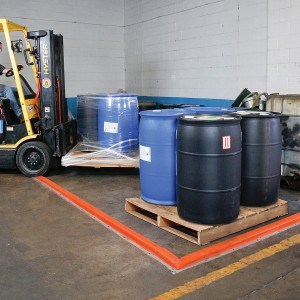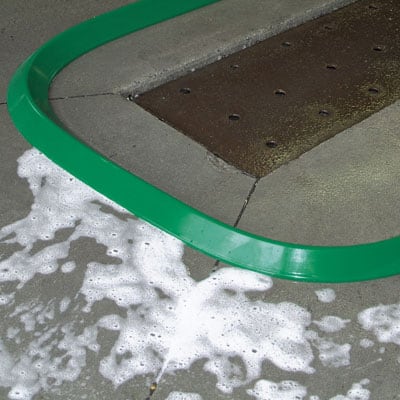When you think about workplace safety, things like PPE, clear signage, or fire exits might come to mind first. But one often overlooked yet essential part of a safe work environment is spill containment. In industries where hazardous materials are handled—whether it’s chemicals, oils, or even large volumes of water—spill containment isn’t just a safety measure, it’s a compliance necessity and a frontline defense against accidents, environmental damage, and costly disruptions.
At Absorbents Online, we’ve seen firsthand how smart spill containment strategies can transform workplace safety from reactive to proactive. Let’s explore why it’s such a game-changer and how it fits into the bigger picture of occupational safety and health.
Why Spill Containment Matters
Imagine a single gallon of oil spilled on a shop floor. It might seem minor, but that slick patch is a serious slip hazard. Now, scale that up to a leaking drum of solvent in a warehouse or a punctured fuel tank on a construction site. The risk isn’t just to people—it’s also to the environment and to your bottom line.
Spill containment is all about limiting the spread of hazardous substances when an incident occurs. It buys time to respond effectively while minimizing exposure and damage. And it’s not optional—agencies like OSHA (Occupational Safety and Health Administration) mandate the use of containment systems in high-risk work environments.
Spill Containment and OSHA Compliance
Under OSHA’s regulations, specifically 29 CFR 1910.120 and 29 CFR 1910.106, employers must provide adequate safeguards when storing and handling flammable or hazardous materials. This includes secondary containment for storage units and readily accessible spill kits.
Non-compliance can lead to stiff penalties, but even more importantly, it puts your workers and community at risk. Effective spill containment isn’t just about ticking a regulatory box—it’s about creating a culture of safety and responsibility.

Tools of the Trade: What Does Spill Containment Look Like?
When people hear “spill containment,” they often think of big hazmat-style barriers. But the reality is far more flexible and customizable.
Here are some of the common spill containment solutions we provide at Absorbents Online:
- Spill Pallets: Ideal for drum storage, these platforms catch leaks and drips before they hit the floor.
- Containment Berms: Think of these as portable bunds that can surround larger equipment or tanks.
- Absorbent Pads and Rolls: Quick, convenient solutions for wiping up spills as they occur.
- Spill Kits: Pre-packaged sets that include everything needed to handle spills, from PPE to absorbents.
- Drain Covers and Seals: Prevent chemicals from entering storm drains or waterways.
Each solution plays a specific role depending on the type of material, quantity, and location involved.
Beyond the Floor: The Environmental Stakes
Spills don’t just stop at the shop floor. Without containment, liquids can seep into drains, soil, or water sources—leading to environmental contamination. This is especially true for oil-based products and industrial chemicals that persist in ecosystems.
In fact, the EPA can issue fines or sanctions if a workplace spill results in water pollution or soil damage. Preventative containment solutions are not only smart—they’re sustainable. By catching a problem early, you’re saving not just money, but also the local environment.
Training: Your First Line of Defense
The best spill containment equipment in the world won’t help if no one knows how to use it. That’s where employee training becomes essential.
Regular training programs should cover:
- Proper use of absorbents and containment tools
- Evacuation procedures
- Hazard recognition and communication
- PPE usage and first aid
Training boosts confidence and response speed. It also ensures that every team member knows their role when things go wrong—whether it’s plugging a leak or safely guiding others away from the danger zone.
Emergency Response: Reacting with Confidence
Even the most robust containment plans can’t prevent every incident. That’s why a clear and tested emergency response plan is vital. This includes:
- Accessible spill kits placed strategically
- Chain-of-command reporting
- Communication protocols with external responders (like fire departments)
- Post-spill cleanup and incident reporting
When everyone knows what to do, small spills stay small—and large spills don’t become disasters.

Comparing Common Workplace Spill Risks
Let’s take a look at how different industries implement spill containment:
1. Manufacturing Plants
High volumes of lubricants and chemicals mean frequent, low-volume spills. Absorbent mats, drum containment, and floor drains are key here.
2. Warehouses
Forklift traffic and stacked drums increase the risk of punctures or knocks. Secondary containment pallets and clear labeling help reduce accidents.
3. Construction Sites
Outdoor and mobile operations require flexible containment like spill berms and portable kits.
4. Automotive Shops
Oil and coolant spills are daily events. Shop towels and floor pads, along with proper disposal containers, are crucial.
5. Food Processing
Even water or cleaning agents can pose slip risks. Non-chemical absorbents and hygiene-safe barriers are often needed.
Every workplace has unique needs, but preparedness is universal.
Final Thoughts: Make Containment a Culture
At the end of the day, spill containment is about more than just products—it’s about peace of mind. Knowing that your team is trained, your equipment is compliant, and your protocols are ready can turn a potential crisis into a controlled response.
When spill containment becomes second nature, you don’t just meet safety standards—you set them.
At Absorbents Online, we’re here to help you build that kind of safety culture. From sourcing the right absorbents to guiding your containment strategy, our mission is to make workplace safety simple, effective, and sustainable.
Need help evaluating your containment setup?
Reach out today and we’ll help you customize a solution that protects your people, your business, and your environment.